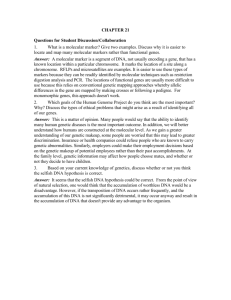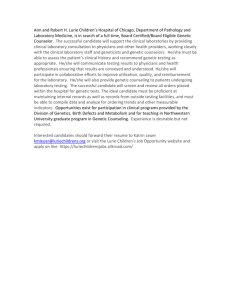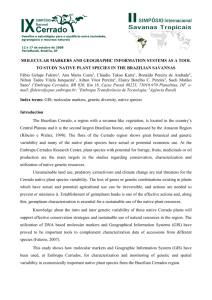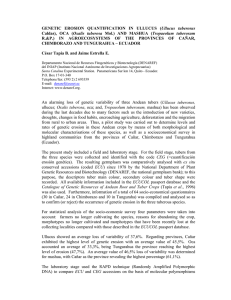use of molecular markers and geographic information systems to
advertisement
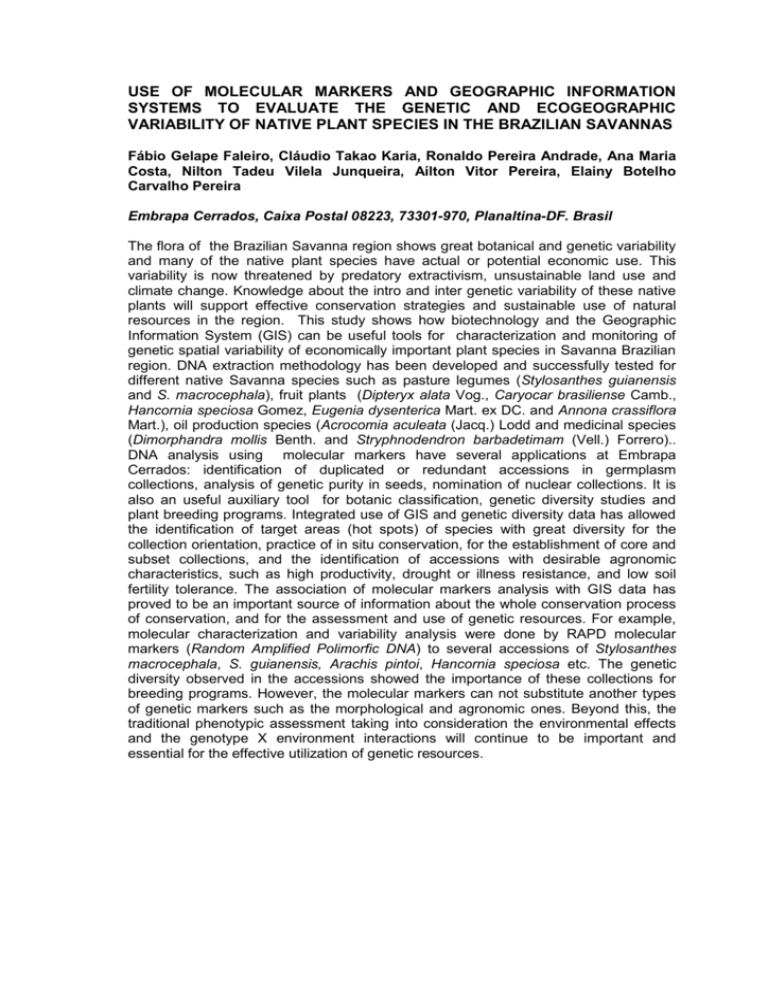
USE OF MOLECULAR MARKERS AND GEOGRAPHIC INFORMATION SYSTEMS TO EVALUATE THE GENETIC AND ECOGEOGRAPHIC VARIABILITY OF NATIVE PLANT SPECIES IN THE BRAZILIAN SAVANNAS Fábio Gelape Faleiro, Cláudio Takao Karia, Ronaldo Pereira Andrade, Ana Maria Costa, Nilton Tadeu Vilela Junqueira, Aílton Vitor Pereira, Elainy Botelho Carvalho Pereira Embrapa Cerrados, Caixa Postal 08223, 73301-970, Planaltina-DF. Brasil The flora of the Brazilian Savanna region shows great botanical and genetic variability and many of the native plant species have actual or potential economic use. This variability is now threatened by predatory extractivism, unsustainable land use and climate change. Knowledge about the intro and inter genetic variability of these native plants will support effective conservation strategies and sustainable use of natural resources in the region. This study shows how biotechnology and the Geographic Information System (GIS) can be useful tools for characterization and monitoring of genetic spatial variability of economically important plant species in Savanna Brazilian region. DNA extraction methodology has been developed and successfully tested for different native Savanna species such as pasture legumes (Stylosanthes guianensis and S. macrocephala), fruit plants (Dipteryx alata Vog., Caryocar brasiliense Camb., Hancornia speciosa Gomez, Eugenia dysenterica Mart. ex DC. and Annona crassiflora Mart.), oil production species (Acrocomia aculeata (Jacq.) Lodd and medicinal species (Dimorphandra mollis Benth. and Stryphnodendron barbadetimam (Vell.) Forrero).. DNA analysis using molecular markers have several applications at Embrapa Cerrados: identification of duplicated or redundant accessions in germplasm collections, analysis of genetic purity in seeds, nomination of nuclear collections. It is also an useful auxiliary tool for botanic classification, genetic diversity studies and plant breeding programs. Integrated use of GIS and genetic diversity data has allowed the identification of target areas (hot spots) of species with great diversity for the collection orientation, practice of in situ conservation, for the establishment of core and subset collections, and the identification of accessions with desirable agronomic characteristics, such as high productivity, drought or illness resistance, and low soil fertility tolerance. The association of molecular markers analysis with GIS data has proved to be an important source of information about the whole conservation process of conservation, and for the assessment and use of genetic resources. For example, molecular characterization and variability analysis were done by RAPD molecular markers (Random Amplified Polimorfic DNA) to several accessions of Stylosanthes macrocephala, S. guianensis, Arachis pintoi, Hancornia speciosa etc. The genetic diversity observed in the accessions showed the importance of these collections for breeding programs. However, the molecular markers can not substitute another types of genetic markers such as the morphological and agronomic ones. Beyond this, the traditional phenotypic assessment taking into consideration the environmental effects and the genotype X environment interactions will continue to be important and essential for the effective utilization of genetic resources.







